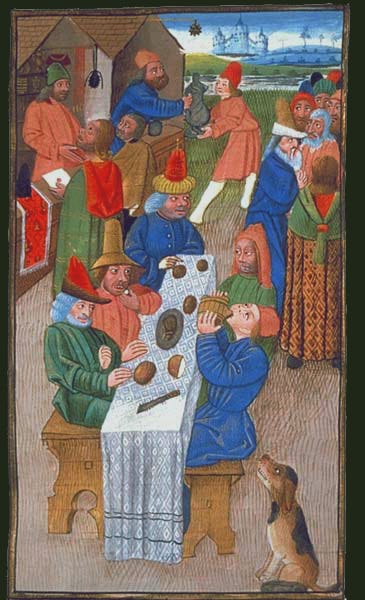Did Peasants in the Middle Ages Eat Beef
What Did Peasants Eat in Medieval Times?
They ate more than only breadstuff. They were culinary innovators!

 W hen you call up about a typical medieval peasant meal, what's the first that comes to mind? Besides breadstuff, probably non a whole lot, right? Well, you'd be surprised at how varied their diets were. Medieval peasants were like us in that they'd speedily got bored of eating the same bland nutrient.
W hen you call up about a typical medieval peasant meal, what's the first that comes to mind? Besides breadstuff, probably non a whole lot, right? Well, you'd be surprised at how varied their diets were. Medieval peasants were like us in that they'd speedily got bored of eating the same bland nutrient.
Since peasants lived very physical lives, they needed many calories to get them through the day. Depending on which region they came from, they had access to a broad range of foods past growing, foraging, and even line-fishing.
Many dishes were packed with nutrients and had everything that a balanced repast required. Peasant nutrient wasn't total of muck and grime; they were the paradigm of a healthy diet.
Bread Was the Staple
Although today, brown breadstuff is more expensive and considered a healthier option, it required less attempt to produce during medieval times, making it cheap and attainable for peasants.
In contrast, white breadstuff was highly sought after, not just because information technology was more expensive and considered a status symbol, but because the colour of the bread meant that it was harder to cheat people equally information technology could non be dyed or discoloured equally easily.
Near of the staff of life eaten by peasant'south was a type of dark bread made from rye grain. This was oft hard and difficult to chew with the Swedish botanist Carl Von Linnè noting the post-obit:
"Soft bread is used mainly by the aristocracy and the rich, but it weakens the gums and teeth, which get besides petty exercise in chewing. However, the peasant folk who swallow hard breadstuff cakes generally accept stronger teeth and firmer gums."
The blazon of staff of life did vary, however. In France, nigh peasants ate a type of bread made from wheat and rye called meslin .
All the same, in the Polish city of Wroclaw, people could buy ordinary white bread, rye bread, wheat rolls, and even flat cakes. Living in an urban settlement provided more pick, but since most peasants lived in rural communities, these weren't always available.
Even outside Europe, bread was widely consumed. In one of the earliest known Arab cookbooks, Ibn Sayyar al-Warraq noted the following:
"Wheat bread agrees with almost everybody, particular varieties made with a generous corporeality of yeast and salt and allowed to fully ferment and bake well. Such breads are lighter and digest faster. Jizmazaj (thin breadstuff with tamarisk seeds) and ruqaq (very thin breadstuff) are past comparison less nourishing and digest much faster. Bread baked in malla (pit with hot ashes and stones), tabaq (large flat pan) and whatever other like varieties that practice non ferment or bake well are difficult to digest and cause breadbasket aches. Only people used to strenuous labor can eat them more than oft."
Bread was the ground of the medieval nutrition, and it was the staple for anybody, regardless of their wealth or condition.
Meals were Diverse
Although meat was very expensive, there were instances of peasants eating stews fabricated with beef and leafy vegetables. In England, meat was reserved for banquet days and celebrations, then it'south non that peasants would never eat meat; they'd but consume information technology on rare occasions.
Fish was as well expensive, but for those that lived by the sea or near lakes and rivers, they were an essential source of protein. Nearly fish would exist dried, smoked or salted, only they could also exist eaten fresh if the local lord allowed fishing.
Since the upper classes preferred meat over fish, many peasants were immune to fish, and freshwater species like perch, throughway and trout were frequent dishes at the dinner table. Salmon was particularly popular, and even porpoises and whales were consumed. The latter would be sold in large slices at European marketplaces, and according to a author from the sixteenth century, 'were it cooked for xx-iv hours it would still be very difficult and indigestible.'
Foraging was likewise important, and mushrooms, herbs, and other root vegetables were usually used in making pottage, a type of stew made in a pot. Pea pottage was the main choice for supper and would exist slow-cooked over a fire. It was a very hearty and healthy repast, ordinarily containing peas, onions and herbs establish in the wild.
Spices were far as well expensive and out of reach for most peasants, so instead, many got creative with the herbs they could find.
One item herb, sorrel, would be basis and strained under a linen material to produce a sauce. Other herbs like parsley could also be used, and this would make a green sauce that could be added to fish, pottage, or other dishes to enhance their flavour.
They Were Innovative Dessert Makers
Sweeter sauces could be made from grounded up almonds, simply they were ordinarily reserved for the rich. For peasants, love was the preferred choice for sweetening food as it wasn't costly. Most monasteries had several hives entrusted to peasant beekeepers equally the prized wax was sold to candle makers.
According to a medieval French cookbook from 1393, candy-coated fruits were fairly popular desserts, and different variations could be made from locally grown fruit mixed with dear. I recipe described the process for making candied orange peel imported from Iberia:
"To brand candy-coated orangish skin, cut the peel of one orange into five pieces and scrape off the pith with a pocketknife. Then soak the peels in nice fresh h2o for 9 days, changing the water every twenty-four hours. Afterwards that, bring them just to a boil in fresh water, then spread them on a cloth and let them dry out very well. Put them in a pot and encompass with honey, and boil over a depression fire and skim. To exam whether the honey is cooked, drop one driblet of hot love into a bowl of water. If it spreads, it is not cooked; merely if the drop of honey holds together in the h2o without spreading, it is cooked. Draw out the orangish peels one at a time and layer them, sprinkling with ginger pulverization betwixt each layer, usque in infinitum. Allow flavour a month or more earlier eating."
In improver to love, peasants likewise reared cows for their milk which would so exist turned into cheese. In 2019, scientists uncovered the remains of cooking pots about the medieval village of West Cotton:
"This report has provided valuable information on diet and animal husbandry by medieval peasants and helped illustrate agricultural production, consumption and economic life in one of England'south early on medieval villages."
It seems as though peasants did enjoy eating desserts, and with the abundance of honey equally a sweetener, sugar wasn't needed to brand a delicious treat, fifty-fifty if the concluding product was hard to chew.
They Drank 'Small Beer'
Beer was widely consumed by peasants non merely because it was cheap merely because it was effective at delivering both calories and fluids. Peasants worked all solar day and needed a lot of energy, so when they weren't able to eat their calories, they would ingest them by drinking.
Medieval beer was made past mixing grains, malt, and water and letting information technology ferment for a twenty-four hours. This besides gave information technology a very low alcohol content, less than 2.8% and was drunk at breakfast, almost similar having a poly peptide milk shake earlier a workout.
Beer was and then widely consumed that children equally young as five would have it, and during the twelfth century, there was fifty-fifty a national levy on ale in England to support the crusades.
Of course, not everyone drank beer all the time. Water was still preferred, and since most towns and villages were centred around a river, it wasn't difficult to access a clean water source. Where information technology did become an outcome, however, was in urban centres. Contaminated water had a foul odour, and smelling a drink was one fashion of knowing whether it was harmful or not.
Beer was the universal selection of drink, non only because it was less decumbent to contamination simply because, unlike water, information technology provided calories to fuel the working mean solar day.
How Oftentimes Did They Eat?
Although nosotros think of breakfast equally the most important meal today, medieval peasants would eat their main meal at lunchtime, between eleven in the morning and ii in the afternoon.
A typical working peasant would wake up at dawn, have a light snack, usually something cold like bread or cheese, and then go out into the fields. Breakfast wasn't really a tradition because there wasn't plenty time to prepare a full meal, particularly earlier sunrise.
After working for several hours, they'd return past apex, and this was when the main meal of the twenty-four hour period would be served. It was easier to prepare tiffin during daylight hours, and the women who were cooking had ample time to set the food.
Information technology was too a adept time to take a break since, by this indicate, working peasants would become hungry, and they yet had the residuum of the afternoon to worry about.
By the time it got dark, peasants would retire to their homes and spend the remaining time socialising. Since the day had concluded, in that location wasn't a need for a large meal. Candles and lanterns weren't always available either, so eating a large dinner was out of the question.
While today, we unremarkably eat iii main meals, with snacks in between, peasants would eat two primary meals during the twenty-four hour period, followed by a light dinner in the evening. Snacks, including bread, beer, or smoked fish, could exist taken while working and were mutual during summer when the days were longer.
There has always been a misconception most the peasant diet. Certain, during times of famine, they'd accept to resort to eating whatever they could find, just under normal circumstances, they ate reasonably well.
If peasants were out working all mean solar day, they needed large amounts of calories from their nutrient, and so they had to consume well. Bread was important, but fishing, foraging, and the occasional donation from a local lord fabricated up much of the poly peptide shortage.
Today, we're encouraged to eat more light-green vegetables and organic produce. While the rich gorged on meat and had decadent tastes, it's not their diet that we should aspire to emulate; information technology's the peasant's diet.

If you lot enjoyed this read, and so yous may be interested in the following stories:
![]()
The Mysterious Eating Habits of Historical People
P.South — Get-go, y'all should get my posts in your inbox. Do that hither! Secondly, if you'd like to feel Medium fully, consider supporting me and thousands of other writers by signing up for a membership. It only costs $five a month, and you have the chance to make money with your writing also. By signing up with this link , you lot'll back up me straight with a portion of your fee at no actress price. Even if yous choose not to, I cheers for taking the fourth dimension to read through this story and hope that you were able to learn something new. That, for me, is more than than plenty.
Source: https://historyofyesterday.com/what-did-peasants-eat-in-medieval-times-7a9306cd73c3
0 Response to "Did Peasants in the Middle Ages Eat Beef"
Post a Comment